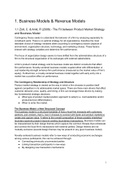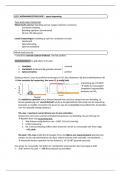Resume
JADS Master - Strategy & Business Models Summary (Business Models & Revenue Models)
- Cours
- Établissement
Summary for the Strategy & Business Models course readings of the Master Data Science and Entrepreneurship. Includes summaries for the following papers: * Zott, C. & Amit, R (2008) - The Fit between Product Market Strategy and Business Model * Hartmann, P., Zaki, M., Feldmann, N. and ...
[Montrer plus]




